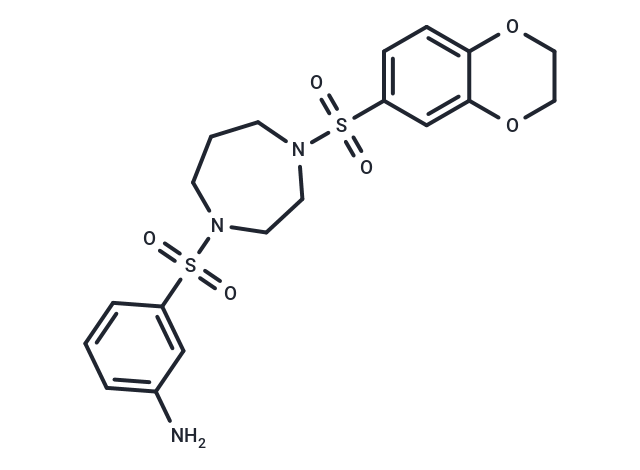Shopping Cart
- Remove All
 Your shopping cart is currently empty
Your shopping cart is currently empty

DASA-58 is a specific and potent Pyruvate kinase M2 (PKM2) activator.

| Pack Size | Price | Availability | Quantity |
|---|---|---|---|
| 2 mg | $37 | In Stock | |
| 5 mg | $64 | In Stock | |
| 10 mg | $97 | In Stock | |
| 25 mg | $198 | In Stock | |
| 50 mg | $345 | In Stock | |
| 100 mg | $547 | In Stock | |
| 1 mL x 10 mM (in DMSO) | $70 | In Stock |
| Description | DASA-58 is a specific and potent Pyruvate kinase M2 (PKM2) activator. |
| In vitro | DASA-58 inhibits LPS-induced Hif-1α and IL-1β, as well as the expression of a range of other Hif-1α-dependent genes in primary BMDMs, and also inhibits glycolysis and the accumulation of succinate in LPS-activated macrophages. [1] In PC3 cells, DASA-58 impairs stromal-induced EMT program by restoring PK activity and abrogating the nuclear translocation of PKM2, as well as its association with HIF-1α. DASA-58 also dramatically reduces (~6-fold) CAFs-induced lung metastases formation in PC3 cells. [2] |
| In vivo | DASA-58 (40 μM) affects EMT of prostate cancers and tumor dissemination in SCID mice. [2] |
| Kinase Assay | CDK kinase assay: Kinase assays are performed in 96-well polypropylene plates. Each reaction contained 2 μg of histone H1 at a final concentration of 10 μM [γ-33P]ATP (0.2 μCi/well; approximately twice the experimentally determined Km), 10 mM MgCl2, 1 mM DTT, 0.01% Triton X-100, and 10% glycerol in a 40 μL volume. The reaction is initiated with the addition of 20 μL enzyme (6 ng cdk2/well resulting in a final concentration of 1.6 nM), which is previously diluted 1:50–1:200 in the same buffer, and allowed to proceed for 1 h at room temperature. Reaction is stopped by the addition of 0.01 mL 10% phosphoric acid, and 25 μL of reaction mixture is transferred to P30 phosphocellulose filter mat paper. The filter mat is washed three times with 1.0% phosphoric acid, air dried, and then counted for radioactivity in a liquid scintillation counter. The cdk4 kinase assay for cyclin D1-cdk4 is carried out in a polypropylene 96-well microtiter plate format measuring the incorporation of radioactive phosphate into GST-Rb. Purified cyclin D1-cdk4 is incubated with 1 μg GST-Rb in 20 mM HEPES (pH 7.5) in the presence of 10 mM MgCl2, 1 mM DTT, 0.01% Triton X-100, and 10% glycerol. The final cdk4 concentration is 10 ng/well, or 1.6 nM. Kinase reaction is initiated by the addition of ATP at a final concentration of 10 μM ATP (twice the experimentally determined Km) and [γ-33P]ATP (1.0 μCi per well) in a 60-μL volume and allowed to proceed at room temperature for 1 h. Reaction is stopped by the addition of 0.01 ml 10% phosphoric acid, and 25 μL of reaction mixture is transferred to P30 phosphocellulose filter mat paper. The filter mat is treated as for Cdk1/Cdk2 assays. |
| Molecular Weight | 453.53 |
| Formula | C19H23N3O6S2 |
| Cas No. | 1203494-49-8 |
| Smiles | Nc1cccc(c1)S(=O)(=O)N1CCCN(CC1)S(=O)(=O)c1ccc2OCCOc2c1 |
| Relative Density. | 1.453 g/cm3 (Predicted) |
| Storage | Powder: -20°C for 3 years | In solvent: -80°C for 1 year | Shipping with blue ice. | |||||||||||||||||||||||||||||||||||
| Solubility Information | Ethanol: < 1 mg/mL (insoluble or slightly soluble) DMSO: 84 mg/mL (185.21 mM), Sonication is recommended. H2O: < 1 mg/mL (insoluble or slightly soluble) | |||||||||||||||||||||||||||||||||||
Solution Preparation Table | ||||||||||||||||||||||||||||||||||||
DMSO
| ||||||||||||||||||||||||||||||||||||

Copyright © 2015-2025 TargetMol Chemicals Inc. All Rights Reserved.